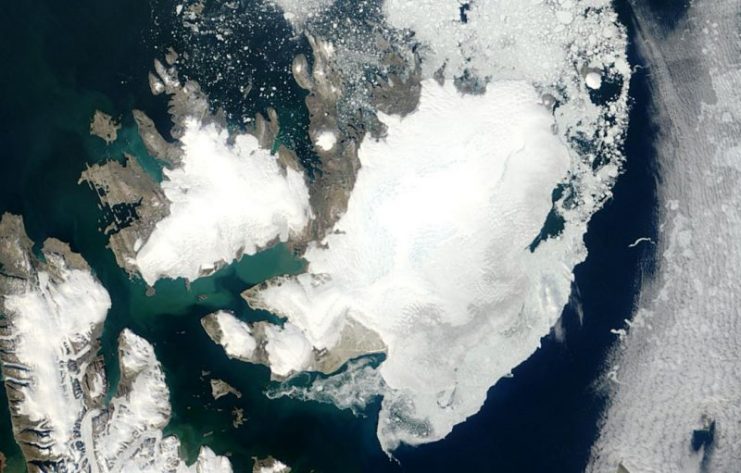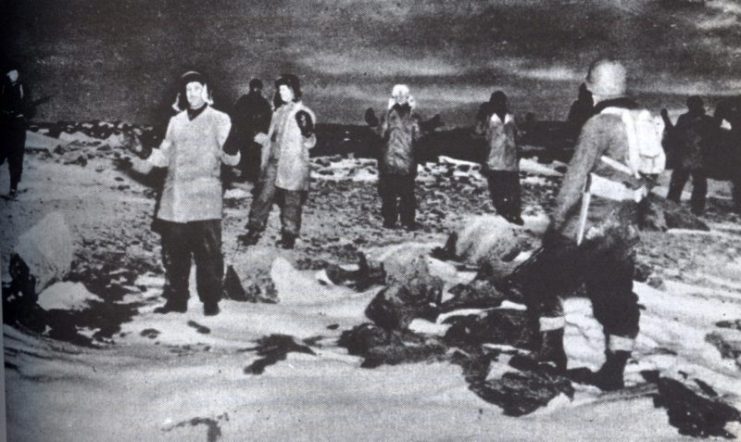Deep inside the Arctic circle, some six-hundred miles North of the Norwegian coast, lies the Svalbard archipelago, including the islands Spitzbergen and Nordaustlandet (North East Land).
In the September of 1944 eleven German soldiers were sent to Nordaustlandet in order to send weather reports back to the mainland.
A new documentary has been produced that tells the story of the eleven men and why it took so long for the Swashbuckler squad to be able to surrender. In short, the reason was simply that there was no one they were able to surrender to.
For an entire year the team had been dutifully compiling and broadcasting weather reports, communicating daily with the German military and had heard immediately when Germany surrendered to the Allies on May 8th, 1945. They continued reporting the weather, uncoded following the cessation of hostilities, but failed to hear anything by return.
The British took control of the country and interned 375,000 German troops, leaving the Nazi communications monitored by one man, Rolf Wieck. Despite reminders to the British commanders that a unit remained in the Svalbard Archipelago, no one was prepared to take responsibility for picking the squad up.

The Swashbucklers were led by polar expert and geographer Wilhelm Dege and had expertise in Winter and mountain combat and training in cooking, baking, dentistry and emergency amputation. They built a weather station and had a years’ worth of provisions and a good supply of weapons.
The squad buckled down for a long hard winter in a part of the world where the sun would remain below the horizon for weeks and the air temperature would drop below -50C. They saw no military action but shared the island with walrus colonies, polar bears and other arctic wildlife.
The following Spring, insulated from the chaos of the battle for Europe and the cataclysmic razing of many German cities, the team heard the news that Hitler had committed suicide. Heinz Schneider was the bases’ 21-year-old radio operator at the time. He remembered that they broke out the schnapps on that fateful May 1st and raised their glasses to the new era that was to come.
Their optimism was to be short-lived however as their expectation of relief faded as the months dragged on. Through the Summer months of June and July, while Europe basked in the heady rush of liberation, the polar weather crew watched as their provisions gradually depleted.
When there was still no sign of a rescue in August the men began to prepare for the Winter that was to come. Eventually, at the end of the month on the 25th, August 1945, a message came in from the mainland detailing that a Norwegian fishing vessel would be dispatched to pick them up.
The Blaasel, captained by an old colleague of Dege’s, Captain Albertsen, arrived off the coast of Nordaustlandet on September 3rd. Both Dege and Albertsen had worked together on polar expeditions in the 1930’s, and the men greeted each other with a hug when they met that day.

That night the sailors were treated to a meal at the weather station, followed by stories and reminiscences and drinking of schnapps. In the small hours of the 4th September Captain Albertsen remarked that it was all very well but that Lieutenant Dege had yet to formally surrender.
In reply, Wilhelm Dege unholstered his pistol and laid in on the table between the two men saying, ‘I hereby capitulate!’ making his squad of German soldiers the last to surrender in World War Two.
Another Article From Us: Historic D-Day Railway Station Visited by Churchill, de Gaulle & Eden up for Sale
Dege returned to his scientific career following the war, he lectured at a university and wrote a memoir of his experiences on the Svalbard Archipelago called War North of 80. He died in 1979.
